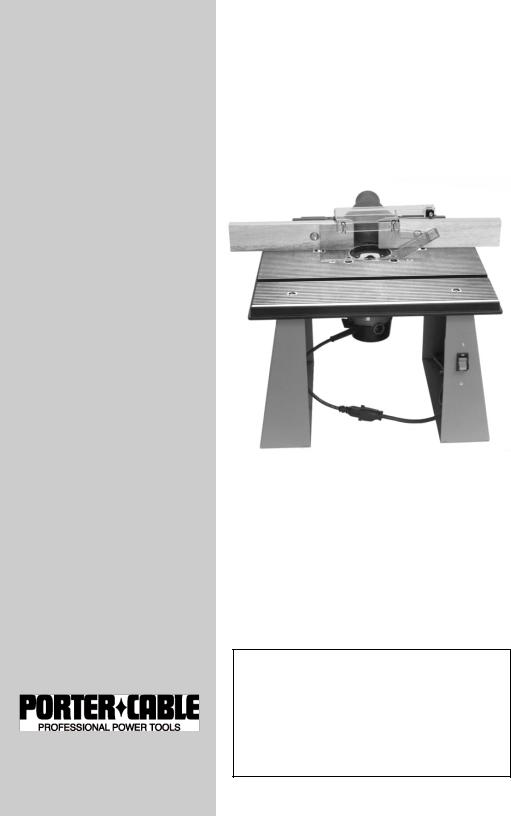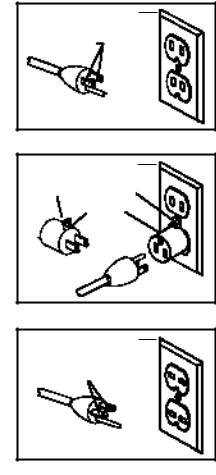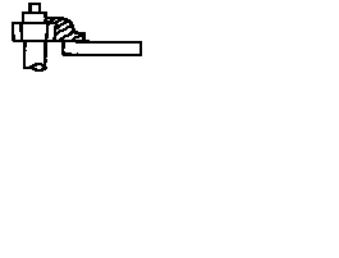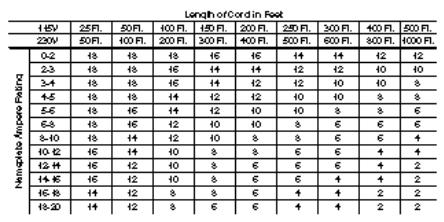Porter-Cable 698, 697 User Manual

|
|
ESPA OL: P`GINA 19 |
|
|
FRANúAISE : PAGE 37 |
Instruction |
|
|
Router/Shaper |
||
manual |
and Shaper Table |
|
To learn more about Porter-Cable visit our website at:
http://www.porter-cable.com
MODEL 697 Router/Shaper Complete
MODEL 698 Shaper Table Only
IMPORTANT
Please make certain that the person who is to use this equipment carefully reads and understands these instructions before starting operations.
The Model and Serial No. plate is located on the main housing of the tool. Record these numbers in the spaces below and retain for future reference.
Model No. __________________________________
Type_______________________________________
Serial No. ___________________________________
Part No. 884901-991

SAFETY INSTRUCTIONS
GROUNDING INSTRUCTIONS
This tool should be grounded while in use to protect the operator from electric shock. The tool is equipped with an approved three-conductor cord and threeprong grounding type plug to fit the proper grounding type receptacle. The green (or green and yellow) conductor in the cord is the grounding wire. Never connect the green (or green and yellow) wire to a live terminal.
If your unit is for use on less than 150 Volts, the power cord is equipped with a plug that has two flat, parallel current-carrying prongs and one longer, round or U -shaped, ground prong which requires a mating 3- conductor grounded type receptacle, as shown in Fig. 1.
An adapter, shown in Fig. 2, is available for connecting 3-prong grounding type plugs that are used on units less than 150 Volts to 2-prong receptacles. THIS ADAPTER IS NOT ALLOWED IN CANADA. The green colored rigid ear, lug, etc., must be connected to a permanent ground such as a properly grounded outlet box, as shown in Fig. 2.
If your unit is for use on 150 to 250 Volts, the power cord is equipped with a plug that has two flat current carrying prongs in tandem, and one round or U -shaped, longer ground prong, as shown in Fig. 3. This plug is used only with the proper mating 3- conductor grounding type receptacle, as shown in Fig. 3. No adapter is available for this type plug.
IN ALL CASES, MAKE SURE THE RECEPTACLE IN QUESTION IS PROPERLY GROUNDED.
GROUNDED OUTLET BOX
CURRENT
CARRYING
PRONGS
GROUNDING PRONG
IS LONGEST OF THE 3 PRONGS
Fig. 1
GROUNDED OUTLET BOX
GROUNDING MEANS
ADAPTER
Fig. 2
GROUNDED OUTLET BOX
CURRENT
CARRYING
PRONGS
GROUNDING PRONG
IS LONGEST OF THE 3 PRONGS
Fig. 3
NEVER REMOVE GROUNDING PRONG FROM POWER PLUG.
EXTENSION CORDS
Use only three-wire extension cords which have three-prong grounding-type plugs and three-pole receptacle which accept the tool s plug. Replace damaged or worn cord immediately. DO NOT ATTEMPT TO REPAIR POWER CORD.
2
IMPORTANT SAFETY INSTRUCTIONS
WARNING: When using electric tools, basic safety precautions should always be followed to reduce the risk of fire, electric shock and personal injury, including the following:
READ AND FOLLOW ALL INSTRUCTIONS.
There are certain applications for which this tool was designed. Porter-Cable strongly recommends that this tool NOT be modified and/or used for any application other than for which it was designed. If you have any questions relative to its application DO NOT use the tool until you have written PorterCable and we have advised you.
Technical Service Manager
Porter-Cable Corporation
4825 Highway 45 North P. O. Box 2468 Jackson, TN 38302-2468
1.KEEP WORK AREA CLEAN. Cluttered areas and benches invite injuries.
2.AVOID DANGEROUS ENVIRONMENT. Don t expose power tools to rain. Don t use power tools in damp or wet locations. Keep area well lit. Avoid chemical or corrosive environment. Do not use tool in presence of flammable liquids or gases.
3.GUARD AGAINST ELECTRIC SHOCK. Prevent body contact with grounded surfaces. For example: pipes, radiators, ranges, refrigerator enclosures.
4.KEEP CHILDREN AWAY. Do not let visitors contact tool or extension cord. All visitors should be kept away from work area.
5.STORE IDLE TOOLS. When not in use, tools should be stored in dry,
and high or locked-up place out of reach of children.
6. DON T FORCE TOOL. It will do the job better and safer at the rate for which it was intended.
7. USE RIGHT TOOL. Don t force small tool or attachment to do the job of a heavy duty tool. Don t use tool for purpose not intended for example do not use a circular saw for cutting tree limbs or logs.
8.DRESS PROPERLY. Do not wear loose clothing or jewelry. Loose clothing, draw strings and jewelry can be caught in moving parts. Rubber gloves and non-skid footwear are recommended when working outdoors. Wear protective hair covering to contain long hair.
9.USE SAFETY GLASSES. Wear safety glasses or goggles while operating power tools. Also face or dust mask if operation creates dust. All persons in the area where power tools are being operated should also wear safety glasses and face or dust mask.
10.DON T ABUSE CORD. Never carry tool by cord or yank it to disconnect from receptacle. Keep cord from heat, oil, and sharp edges. Have damaged or worn power cord and strain reliever replaced immediately. DO NOT ATTEMPT TO REPAIR POWER CORD.
11.MAKE WORKSHOP KIDPROOF. Use padlocks, master switches, or by removing starter keys.
12.SECURE WORK. Use clamps or a vise to hold work when practical.
3
13.DON T OVERREACH. Keep proper footing and balance at all times.
14.MAINTAIN TOOLS WITH CARE. Keep tools sharp and clean for better and safer performance. Follow instructions for lubricating and changing accessories. Inspect tool cords periodically and if damaged, have repaired by authorized service facility. Inspect extension cords periodically and replace if damaged. Have all worn, broken or lost parts replaced immediately. Keep handles dry, clean and free from oil and grease.
15.DISCONNECT TOOLS when not in use, before servicing, and when changing accessories such as blades, bits, cutters, etc.
16. REMOVE ADJUSTING KEYS AND WRENCHES. Form habit of checking to see that keys and adjusting wrenches are removed from the tool before turning it on.
17.AVOID UNINTENTIONAL STARTING. Do not carry a plugged-in tool with finger on switch. Be sure switch is off when plugging in. Keep hands, body and clothing clear of blades, bits, cutters, etc. when plugging in the tool.
18.OUTDOOR USE EXTENSION CORDS. When tool is used outdoors, use
only extension cords marked Suitable for use with outdoor appliances store indoors when not in use.
19.STAY ALERT. Watch what you are doing. Use common sense. Do not operate tool when you are tired or while under the influence of medication, alcohol or drugs.
20.USE RECOMMENDED ACCESSORIES. Consult the owner s manual for recommended accessories. The use of improper accessories may cause risk of injury to persons.
21. NEVER STAND ON TOOL. Serious injury could occur if the tool is tipped or if the cutting tool is unintentionally contacted.
22.CHECK DAMAGED PARTS. Before further use of the tool, a guard or other part that is damaged should be carefully checked to determine that it will operate properly and perform its intended function. Check for alignment of moving parts, binding of moving parts, breakage of parts, mounting, and any other conditions that may affect its operation. A guard or other part that is damaged should be properly repaired or replaced.
23.DIRECTION OF FEED. Feed work into a blade or cutter against the direction of rotation of the blade or cutter only.
24.NEVER LEAVE TOOL RUNNING UNATTENDED. TURN POWER OFF. Don t leave tool until it comes to a complete stop.
25.WEAR EAR PROTECTION to safeguard against possible hearing loss.
SAVE THESE INSTRUCTIONS
ADDITIONAL SAFETY RULES FOR ROUTER/SHAPER
1.DO NOT USE awkward hand positions.
2. |
KEEP |
FINGERS AWAY from revolving cutter use fixtures when |
|
necessary. |
|
|
|
3. |
USE CUTTER |
GUARDS for all applications. |
|
4. |
KEEP |
CUTTER |
GUARDS IN PLACE and in working order. |
5. |
KEEP CUTTERS SHARP. |
||
4

6.NEVER RUN STOCK between fence and cutter.
7.WHEN SHAPING with piloted bit, the pilot must have sufficient bearing surface (1É 8" minimum) as shown in Fig. 1. Fig. 2 illustrates the INCORRECT method for this operation as the pilot DOES NOT have sufficient bearing surface.
|
CORRECT |
|
INCORRECT |
|
|
|
|
|
|
|
|
|
|
|
|
Fig. 1 |
|
Fig. 2 |
|
|
|
|
|
|
8. WHEN SHAPING, the work must be fairly heavy in proportion to the cut being made as shown in Fig. 3. UNDER NO CIRCUMSTANCE should short work of light body be shaped as shown in Fig. 4.
|
CORRECT |
|
INCORRECT |
|
|
|
|
|
|
|
|
|
|
|
|
Fig. 3 |
|
Fig. 4 |
|
|
|
|
|
|
9.THE FENCE should be adjusted endwise so the opening is never more than is required to clear the cutter.
10.CLAMP OR BOLT shaper table securely to workbench to prevent walking .
11.DO NOT USE router bits larger in diameter than those recommended for your router (see SELECTING THE BIT).
12.WHEN SHAPING NARROW MATERIAL, use a push stick and make sure the material is properly supported.
13.WHEN END SHAPING, make sure the material is properly supported by using a miter gauge or back-up block.
14.SOME WOOD CONTAINS PRESERVATIVES WHICH CAN BE TOXIC. Take extra care to prevent inhalation and skin contact when working with these materials. Request, and follow, any safety information available from your material supplier.
REPLACEMENT PARTS
When servicing use only identical replacement parts.
M O TOR
Many Porter-Cable tools will operate on either D.C., or single phase 25 to 60 cycle A.C. current and voltage within plus or minus 5 percent of that shown on the specification plate on the tool. Several models, however, are designed for A.C. current only. Refer to the specification plate on your tool for proper voltage and current rating.
5

CAUTION: Do not operate your tool on a current on which the voltage is not within correct limits. Do not operate tools rated A.C. only on D.C. current. To do so may seriously damage the tool.
EXTENSION CORD SELECTION
If an extension cord is used, make sure the conductor size is large enough to prevent excessive voltage drop which will cause loss of power and possible motor damage. A table of recommended extension cord sizes will be found in this section. This table is based on limiting line voltage drop to 5 volts (10 volts for 230 volts) at 150% of rated amperes.
If an extension cord is to be used outdoors it must be marked with the suffix W-A following the cord type designation. For example SJTW-A to indicate it is acceptable for outdoor use.
RECOMMENDED EXTENSION CORD SIZES FOR USE WITH PORTABLE ELECTRIC TOOLS
OPERATING INSTRUCTIONS
F O R E W O R D
Models 697 and 698 are designed to perform various shaping operations using standard router bits.
Model 698 can be used with any Porter-Cable (or Rockwell) Professional Router. If using Model 7538 or 7539 Plunge Router: a Model 75300 Height Adjustment Knob must be installed and the Shaper Table must be mounted on a Model 6961 Stand (or a cut-out table) that provides clearance for the 75300 Adjustment Knob (the knob will extend below the bottom of the Shaper Table legs).
ASSEMBLING TABLE
1.Locate the two table legs (see Fig. 5) and stand them up parallel to each other and approximately 12" apart. The leg with the switch mounted in it should be to your right, with the switch facing you. Both legs should slant toward the outside.
2.Open hardware package.
3.Place the table on top of the legs, with the miter gauge slot up and the large hole to the rear. Secure the table to the legs with four 1É 4-20 ´ 13É 8" long, flat head screws, split lockwashers, and nuts.
6
